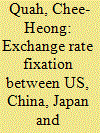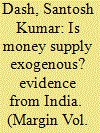|
|
|
Sort Order |
|
|
|
Items / Page
|
|
|
|
|
|
|
| Srl | Item |
| 1 |
ID:
152760


|
|
|
|
|
| Summary/Abstract |
This article examines the effects of capital flows on economic growth in Senegal using autoregressive distributed lag (ARDL) over the period 1970–2014. Overall, our results show that remittances cause economic growth in Senegal in the long run. In contrast, external debt has a negative impact on economic growth. The ARDL results, however, show no cointegration between aid and growth or between foreign direct investment (FDI) and growth. The Quandt–Andrews breakpoint test selects year 1991 as the most likely breakpoint location for the remittances–growth equation. Finally, time-varying parameter analyses using the year 1991 as a slope dummy reveal that remittances have been growth-enhancing post-1991. Therefore, government and policy makers in Senegal must create a favourable atmosphere for attracting more remittances to promote economic development.
|
|
|
|
|
|
|
|
|
|
|
|
|
|
|
|
| 2 |
ID:
152758


|
|
|
|
|
| Summary/Abstract |
This article assesses the feasibility of exchange rate fixation among the largest economies today, namely, the US, Japan, China and Germany/Eurozone, by reviewing variables according to the optimum currency areas framework. The hypothesis is that with greater interconnectedness in general through time there should be greater convergence in the monetary integration dimensions. The period examined spans from 1980 to 2012, an over-30-year period, encompassing the recent episode of global contraction. While the findings are mixed, economically they seem to suggest a general trend towards greater compatibility or at least one which is not in serious contradiction to exchange rate fixity, particularly for the US and Eurozone.
|
|
|
|
|
|
|
|
|
|
|
|
|
|
|
|
| 3 |
ID:
152761


|
|
|
|
|
| Summary/Abstract |
The nexus between international financial integration and economic growth continues to be one of the most debated issues among macroeconomists, and these debates often raise several issues from the theoretical and policy perspectives. Financial integration can catalyse financial development, improve governance and impose discipline on macro-policies. However, in the absence of a basic pre-existing level of supporting conditions, financial integration can aggravate instability (Khadraoui, 2010). In addition, economic theory suggests that increased financial openness intensifies macroeconomic instability. This article investigates the financial integrational effects on macroeconomic instability in terms of output, consumption and investment volatility by employing the vector error correction model (VECM) with empirically reasonably parameters for an emerging economy, India, for the period 1989–2014. From the results, it is evident that financial openness has had a significant effect on output, consumption and investment volatility. Financial development has had a statistically significant negative effect on output, consumption and investment volatility. Similarly, trade openness and terms of trade significantly influence output, consumption and investment volatility.
|
|
|
|
|
|
|
|
|
|
|
|
|
|
|
|
| 4 |
ID:
152763


|
|
|
|
|
| Summary/Abstract |
Against the backdrop of the claim that the rising growth rate of money is one of the major factors behind India’s recent bout of elevated and sticky inflation, this article asks: Is money supply exogenous or endogenous, and can it predict future inflation. This question is investigated using the monetarist framework of inflation. In the empirical analysis of data spanning from 1970–71 to 2009–10, the results of both the monetarist and the error-correction models suggest that money supply accounts for inflation in India. There is also the presence of an error-correction mechanism among money, inflation and output. However, a monetarist equation does not tell anything about causality. Thus, the vector autoregression (VAR) method is used to detect the direction of causality between money supply and the inflation rate. Findings from Granger causality tests suggest weak evidence of inflation (Granger) causing money supply. As a robustness check, we estimate VAR models using quarterly data and, further, using core inflation. The results of the causality tests from the quarterly data, the impulse response function and forecast error variance decomposition suggest that money supply is weakly endogenous.
|
|
|
|
|
|
|
|
|
|
|
|
|
|
|
|
| 5 |
ID:
152765


|
|
|
|
|
| Summary/Abstract |
Since the pioneering studies of Mandelbrot, a great deal of interest has arisen for the parameters of fractal finance theory. With this in mind, the present study attempts to examine the risk composition of S&P 500 index industries through panel data analysis. In the modelling of industries’ stock return risk, we use internal and external variables which are related to the companies’ financial ratios and stock market movements. In the first section (sigma-risk) of the study, we model the stock return risk through standard deviation, while in the second section (alpha-risk), the alpha parameter of stable distributions has been used for the same purpose. Panel data analysis results demonstrate that in the sigma-risk model for the healthcare industry, there is a significant internal variable (roa) that negatively affects the industry risk. However, for the alpha-risk model, some significant variables are obtained for the service industry. Another important finding is the changing level of market risk under the two models. While in the sigma-risk model, the magnitude of the market (external) risk variable is high, under the alpha-risk model, we have seen that market risk is relatively low despite the fact that it still has the highest effect on industry risk.
|
|
|
|
|
|
|
|
|
|
|
|
|
|
|
|
|
|
|
|
|